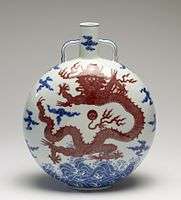Celadon
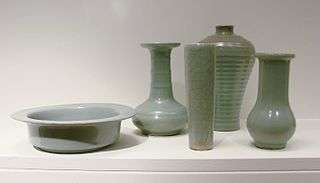
| Celadon | |||||||
| Chinese name | |||||||
|---|---|---|---|---|---|---|---|
| Traditional Chinese | 青瓷 | ||||||
| Simplified Chinese | 青瓷 | ||||||
| |||||||
| Korean name | |||||||
| Hangul | 청자 | ||||||
| Hanja | 靑瓷 | ||||||
| |||||||
| Japanese name | |||||||
| Kanji | 青磁 | ||||||
| Hiragana | せいじ | ||||||
| |||||||
Celadon is a term for pottery denoting both wares glazed in the jade green celadon color, also known as greenware (the term specialists now tend to use) and a type of transparent glaze, often with small cracks, that was first used on greenware, but later used on other porcelains. Celadon originated in China, though the term is purely European, and notable kilns such as the Longquan kiln in Zhejiang province are renowned for their celadon works.[1] Celadon production later spread to other regions in Asia, such as Japan, Korea[2] and Thailand. Eventually European potteries produced some pieces, but it was never a major element there. Finer pieces are in porcelain, but both the color and the glaze can be produced in stoneware and earthenware. Most of the earlier Longquan celadon is on the border of stoneware and porcelain, meeting the Chinese but not the European definitions of porcelain.
For many centuries, celadon wares were highly regarded by the Chinese Imperial court, before being replaced in fashion by painted wares, especially the new blue and white porcelain, under the Yuan dynasty. The similarity of the color to jade, traditionally the most highly valued material in China, was a large part of its attraction. Celadon continued to be produced in China at a lower level, often with a conscious sense of reviving older styles. In Korea the celadons produced under the Goryeo Dynasty (918–1392) are regarded as the classic wares of Korean porcelain.
The celadon colour is classically produced by firing a glaze containing a little iron oxide at a high temperature in a reducing kiln. The materials must be refined, as other chemicals can alter the color completely. Too little iron oxide causes a blue colour (sometimes a desired effect), and too much gives olive and finally black; the right amount is between 0.75% and 2.5%. The presence of other chemicals may have effects; titanium dioxide gives a yellowish tinge.[3] Pieces made with a celadon glaze are themsselves often referred to as "celadons."
Celadon glaze
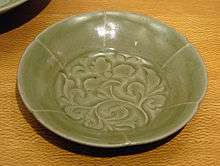
Celadon glaze refers to a family of usually partly transparent but coloured glazes, many with pronounced (and sometimes accentuated) "crackle", or tiny cracks in the glaze produced in a wide variety of colors, generally used on stoneware or porcelain pottery bodies.
So-called "true celadon", which requires a minimum 1,260 °C (2,300 °F) furnace temperature, a preferred range of 1,285 to 1,305 °C (2,345 to 2,381 °F), and firing in a reducing atmosphere, originated at the beginning of the Northern Song Dynasty (960–1127),[4] at least on one strict definition. The unique grey or green celadon glaze is a result of iron oxide's transformation from ferric to ferrous iron (Fe2O3 → FeO) during the firing process.[4] Individual pieces in a single firing can have significantly different colours, from small variations in conditions in different parts of the kiln. Most of the time, green was the desired colour, reminding the Chinese of jade, always the most valued material in Chinese culture.
Celadon glazes can be produced in a variety of colors, including white, grey, blue and yellow, depending on several factors: 1) the thickness of the applied glaze, 2) the type of clay to which it is applied, 3) the exact chemical makeup of the glaze, 4) the firing temperature 5) the degree of reduction in the kiln atmosphere and 6) the degree of opacity in the glaze.
The most famous and desired shades range from a very pale green to deep intense green, often meaning to mimic the green shades of jade. The main color effect is produced by iron oxide in the glaze recipe or clay body. Celadons are almost exclusively fired in a reducing atmosphere kiln as the chemical changes in the iron oxide which accompany depriving it of free oxygen are what produce the desired colors. As with most glazes, crazing (a glaze defect) can occur in the glaze and, if the characteristic is desirable, is referred to as "crackle" glaze.
Etymology
The term "celadon" for the pottery's pale jade-green glaze was coined by European connoisseurs of the wares. One theory is that the term first appeared in France in the 17th century and that it is named after the shepherd Celadon in Honoré d'Urfé's French pastoral romance, L'Astrée (1627), who wore pale green ribbons. (D'Urfe, in turn, borrowed his character from Ovid's Metamorphoses V.210.) Another theory is that the term is a corruption of the name of Saladin (Salah ad-Din), the Ayyubid Sultan, who in 1171 sent forty pieces of the ceramic to Nur ad-Din Zengi, Sultan of Syria.[5] Yet a third theory is that the word derives from the Sanskrit sila and dhara, which mean "green" and "stone" respectively.
Chinese celadons

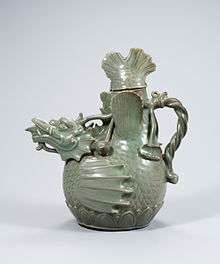
Greenwares are found in earthenware from the Shang dynasty onwards.[3] Archaeologist Wang Zhongshu states that shards with a celadon ceramic glaze have been recovered from Eastern Han Dynasty (25–220 AD) tomb excavations in Zhejiang, and that this type of ceramic became well known during the Three Kingdoms (220–265).[6] These are now often called Proto-celadons, and tend to browns and yellows, without much green.
The earliest major type of celadon was Yue ware,[7] which was succeeded by a number of kilns in north China producing wares known as Northern Celadons, sometimes used by the imperial court. The best known of these is Yaozhou ware.[8] All these types were already widely exported to the rest of East Asia and the Islmamic world.
Longquan celadon wares, were first made during the Northern Song, but flourished under the Southern Song, as the capital moved to the south and the northern kilns declined.[9] This had bluish, blue-green, and olive green glazes and high silica and alkali contents which resembled later porcelain wares made at Jingdezhen and Dehua rather than stonewares.[10]
All the wares mentioned above were mostly in, or aiming to be in, some shade of green. Other wares which can be classified as celadons, were more often in shades of pale blue, very highly valued by the Chinese, or various browns and off-whites. These were often the most highly-regarded at the time and by later Chinese connoisseurs, and sometimes made more or less exclusively for the court. These include Ru ware, Guan ware and Ge ware,[11] as well as earlier types such as the "secret colour" (mi se) wares,[12] finally identified when the crypt at the Famen Temple was opened.
Large quantities of Longquan celadon were exported throughout East Asia, Southeast Asia and the Middle East in the 13th-15th century. Large celadon dishes were especially welcomed in Islamic nations. Since about 1420 the Counts of Katzenelnbogen have owned the oldest European import of celadon, reaching Europe indirectly via the Islamic world. This is a cup mounted in metal in Europe, and exhibited in Kassel in the Landesmuseum.[13] After the development of blue and white porcelain in Jingdezhen ware in the early 14th century, celadon gradually went out of fashion in both Chinese and export markets, and after about 1500 both the quality and quantity of production was much reduced, though there were some antiquarian revivals of celadon glazes on Jingdezhen porcelain in later centuries.[14]
Decoration in Chinese celadons is normally only by shaping the body or creating shallow designs on the flat surface which allow the glaze to pool in depressions, giving a much deeper colour to accentuate the design. In both methods carving, moulding and a range of other techniques may be used. There is very rarely any contrast with a completely different colour, except where parts of a piece are sometimes left as unglazed biscuit in Longquan celadon.
Korea

Chinese celadons were very popular imports to Korea, and inspired local potters. Exceptional high-quality celadons were produced in Korea during the Goryeo and Joseon dynasties.[15] An inlaid celadon technique known as "Sanggam", where potters would engrave semi-dried pottery with designs and place black or white clay materials within the engraving, was invented in Korea during this time.[15][16][17]
Korean celadon, also known as "Goryeo celadon" is usually a pale green-blue in color. The glaze was developed and refined during the 10th and 11th centuries during the Goryeo period, from which it derives its name. Korean celadon reached its zenith between the 12th and early 13th centuries, however, the Mongol invasions of Korea in the 13th century and persecution by the Joseon Dynasty government destroyed the craft.
Traditional Korean celadon ware has distinctive decorative elements. The most distinctive are decorated by overlaying glaze on contrasting clay bodies. With inlaid designs, known as "Sanggam" in Korean, small pieces of colored clay are inlaid in the base clay. Carved or slip-carved designs require layers of a different colored clay adhered to the base clay of the piece. The layers are then carved away to reveal the varying colors. Modern potters, with modern materials and tools, have attempted to recreate Korean celadon techniques.
Gallery
 Yaozhou ware (Northern Celadon), with carved and engraved decoration, 10th century.
Yaozhou ware (Northern Celadon), with carved and engraved decoration, 10th century.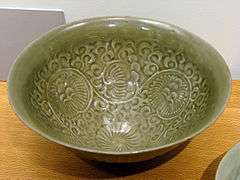 Yaozhou ware Shaanxi province, 10th-11th century, Song Dynasty.
Yaozhou ware Shaanxi province, 10th-11th century, Song Dynasty. Korean Goryeo Celadon,
Korean Goryeo Celadon,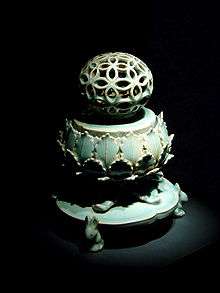 Korean Celadon openwork incense burner with kingfisher glaze from the Goryeo Dynasty. National Museum of Korea
Korean Celadon openwork incense burner with kingfisher glaze from the Goryeo Dynasty. National Museum of Korea Longquan Warmer, 12th Century.
Longquan Warmer, 12th Century. A Ming Dynasty Longquan celadon from Zhejiang, 14-15th century, Smithsonian in Washington, D.C.
A Ming Dynasty Longquan celadon from Zhejiang, 14-15th century, Smithsonian in Washington, D.C. Celadon urine bottle 251 AD. Nanjing, China.
Celadon urine bottle 251 AD. Nanjing, China. Korean Pressed Celadon Goryeo Period
Korean Pressed Celadon Goryeo Period Pitcher in the shape of a Dragon Turtle, National Treasure No. 96 of South Korea
Pitcher in the shape of a Dragon Turtle, National Treasure No. 96 of South Korea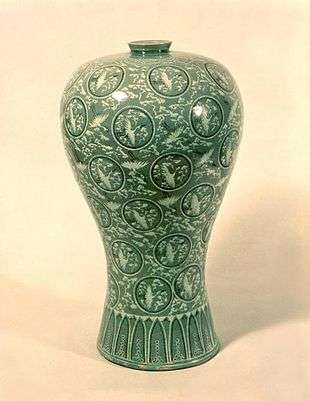 Cheongja sanggam unhak mun maebyeong, the 68th national treasure of South Korea.
Cheongja sanggam unhak mun maebyeong, the 68th national treasure of South Korea. Japanese Kyoyaki Celadon 19th century
Japanese Kyoyaki Celadon 19th century Wanda Golakowska, ceramic ware covered with celadon glaze, Poland, 2nd half of 20th century
Wanda Golakowska, ceramic ware covered with celadon glaze, Poland, 2nd half of 20th century
Notes
- ↑ "Celadon" at the Glossary of Chinese Porcelain Terms
- ↑ "Goryeo Celadon"
- 1 2 Vainker, S.J., Chinese Pottery and Porcelain, 1991, British Museum Press, 9780714114705, pp.53-55
- 1 2 Dewar, Richard. (2002). Stoneware. Philadelphia: University of Pennsylvania Press. ISBN 0-8122-1837-X, p. 42.
- ↑ Dennis Krueger. "Why On Earth Do They Call It Throwing?" from Ceramics Today
- ↑ Wang, Zhongshu. (1982). Han Civilization. Translated by K.C. Chang and Collaborators. New Haven and London: Yale University Press. ISBN 0-300-02723-0.
- ↑ Gompertz, Ch. 1
- ↑ Gompertz, Ch. 4
- ↑ Gompertz, Ch. 6
- ↑ Wood, Nigel. (1999). Chinese Glazes: Their Origins, Chemistry, and Recreation. Philadelphia: University of Pennsylvania Press. ISBN 0-8122-3476-6, pp. 75–76.
- ↑ Gompertz, Ch. 4 and 5
- ↑ Gompertz, Ch. 3
- ↑ http://www.graf-von-katzenelnbogen.com/ Die History of the County of Katzenelnbogen, 600 Years of Bratwurst and the first Riesling of the World
- ↑ Gompertz, Ch. 7 & 8
- 1 2 An Archaeochemical Microstructural Study on Koryo Inlaid Celadon
- ↑ The Rotarian, Dec 1988
- ↑ Science and Civilisation in China, Volume 5
References
- Gompertz, G.St.G.M., Chinese Celadon Wares, 1980 (2nd edn.), Faber & Faber, ISBN 0571180035
Further reading
- Korean art from the Gompertz and other collections in the Fitzwilliam Museum, by Yong-i Yun, Regina Krahl
External links
| Wikimedia Commons has media related to Celadon. |
- Ancient History Encyclopedia - Korean Celadon Pottery
- Eternal Celadon: Ceramics and Jades from East Asia
